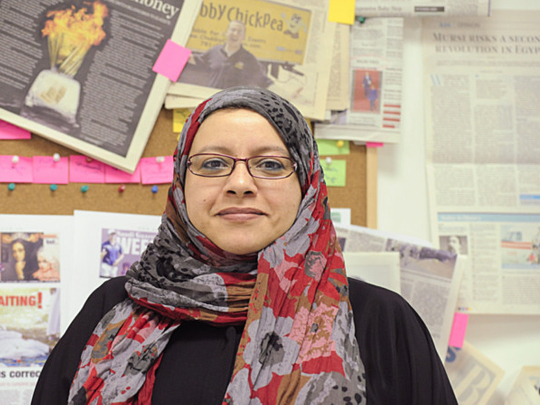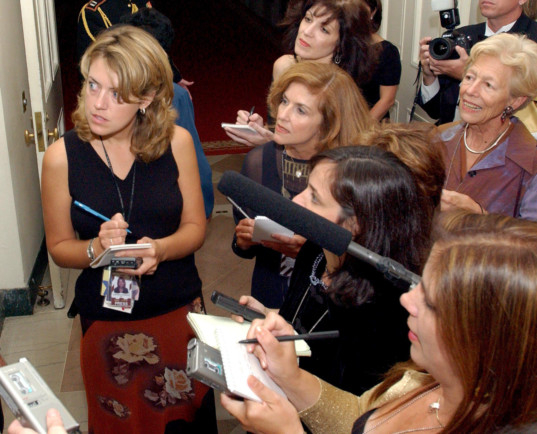
A famous TV presenter announced in early November that he wore, on purpose, the same suit for a year to make a point — to show the sexism his female colleagues face.
“No one has noticed,” presenter Karl Stefanovic, from Australia, was quoted as saying in an interview. “But women, they wear the wrong colour and they get pulled up. They say the wrong thing and there are thousands of tweets written about them.”
“Women are judged much more harshly and keenly on what they do, what they say and what they wear, but I am judged on my interviews, my appalling sense of humour — on how I do my job, basically”, Stefanovic added.
Is it true that men in media get judged according to their talents and skills, while women are judged according to their attire, hair and looks? Or it is just a certain culture? Or only an individual incident?
Not sure, but what is certain is that women in every sector, including media, try hard to show their abilities. Sometimes, they put in more effort than men to achieve their goals.
In media in particular, the saying that behind every great man is a woman can be reversed. It seems that behind every great woman editor there is an “open-minded” male editor.
This applies to some women around the world, including Somayya Jabarti, the first Saudi woman to reach the position of editor-in-chief in her country. She became the editor of the English daily “Saudi Gazette” last February after her boss, mentor and motivator, Khalid Al Maeena, took up another position at the company.
“He was instrumental, definitely. He was vital,” Somayya said of Al Maeena in an interview with Weekend Review.
“He supported me. He is not like other bosses who keep everything to themselves and are territorial. He used to give me tasks coupled with authority to carry them out,” she boasted about her former boss.
Somayya is among a minority of women who feel lucky to have the support and encouragement of a male boss not only in Saudi Arabia, the ultra-conservative, male-dominated society, but also around the world.
Few women occupy senior posts in media worldwide according to an annual report on trends in newsrooms published earlier this year.
The report, which was published by World Association of Newspapers and News Publishers (WAN-IFRA), noted that women are still poorly under-represented in news management.
It quoted several reports and surveys supporting that conclusion; just over a quarter of senior media management positions worldwide are occupied by women, showed a Unesco report; only 12 per cent of major national and metropolitan newspaper editors-in-chief are women, found a report conducted in Australia; only 31 per cent of national titles in South Africa are edited by women, concluded another research; only 16 per cent of the national and metropolitan newspapers in the UK have female editors-in-chief.
In the US, only 10 per cent of “supervisory or upper management” positions in the US newsrooms are occupied by women, according to the “Status of Women in the US Media: 2014” report prepared by the Women’s Media Centre.
However, the New York Times newspaper has realized a milestone — achieving 50 per cent female representation among its top editors. The WAN-IFRA report noted that more women journalists in New York Times are assigned to some of the most coveted jobs in journalism, including foreign posts, political campaigns and investigative reporting. They are also taking on the most dangerous reporting assignments in violence-ridden areas.
Yet, the New York Times had the lowest number of female bylines among the top 10 US newspapers, with 69 per cent of bylines belonging to men, the WAN-IFRA report said.
Earlier, a woman executive editor sat at the helm of the paper. But the American author and journalist Jill Abramson was fired in May 2014 after nearly 32 months of holding the position.
The New York Times publisher publicly said he had problems with Abramson’s management style.
However, according to a report published by the New Yorker, Abramson “discovered that her pay and her pension benefits as both executive editor and, before that, as managing editor were considerably less than the pay and pension benefits” of the male editor she replaced. “She confronted the top brass,” one close associate was quoted as saying.
Eileen Murphy, a spokeswoman for the Times, was quoted as saying that Jill Abramson’s total compensation as executive editor “was directly comparable” to her predecessor — “though it was not actually the same” the New Yorker report added.
“She (Abramson) had a lawyer make polite inquiries about the pay and pension disparities, which set them (bosses) off.”
There is an ongoing need for women to be more forceful in promoting their capabilities and demanding party parity, Lisa MacLeod, a former Financial Times managing editor was quoted as saying in the WAN-IFRA report.
“Most women are less aggressive than men in demanding equal pay for equal work, at least, and less confident when negotiating their position at work. That is a broad generalisation. On one occasion, I actually ended up coaching somebody on how to ask for a raise — from me,” MacLeod added.
Somayya echoed similar opinion.
“I don’t think it is because we don’t know how to negotiate. I think we tend to give ourselves less credit than what we are worth,” Somayya said.
“One of the things that enable men to go and negotiate in a hard manner is their feeling that they are entitled to something better. We (women) go in with a bit of hesitance and that has to do with confidence.”
This might be because generally speaking, “we (women) are always regarded as lower achievers,” she added. “When we come to ask for a raise or any other financial gain, we ask (ourselves) would I deserve this? Am I worth it? As if I am asking for something that isn’t mine. Women need to encourage each other about this.”
When a female colleague talks to Somayya about a raise, she said “I take the opportunity to tell her, you shouldn’t hesitate about this. You should take the initiative.”
Women in Arab male-dominated societies should be raised with confidence at an early age, she noted. Little girls should be raised with the belief that “you were born entitled. Then you will learn how to exercise this entitlement and how to apply it. It will make a whole lot of difference,” Somayya added.
Senior women editors from different parts of the world were quoted in a report as urging women journalists and other editors to be as visible as possible, adding that “media is about visibility”.
Women also need to take every opportunity to manage projects or people, and to find “a reliable mentor”.
“I don’t want to discourage any women from seeking leadership, but I would strongly recommend she arm herself by finding a good mentor, even if it is a paid professional relationship,” former Sydney Morning Herald editor-in-chief Amanda Wilson added.
If media organisations are serious about hiring women to senior editorial positions, “more flexibility is required to accommodate women with children,” added the report.
When women editors have to choose between their job and families, they would opt for the latter.
What is needed are women with noticeable influence, said Somayya and not just women promoted by men who like “to take credit for promoting women, but they don’t give then the authority to make decisions.”
Insufficient number of women in leading positions in media is a global phenomenon.
India passed a law in 2013 with varying deadlines for firms, including media firms, depending on turnover, which aims to boost women’s participation in top positions by putting at least one woman in the boardroom of listed companies.
Accordingly, India’s richest businessman Mukesh Ambani appointed his wife as a director of his conglomerate Reliance Industries last June. Ambani already owns one of the biggest media outlets in India.



